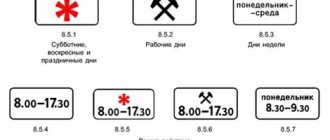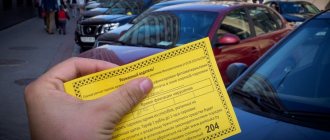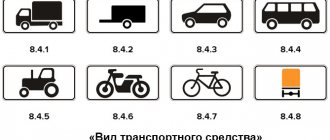The “Give Way” sign looks like a white triangle with a red border stripe along the edge. An equilateral triangle is located in an “inverted” position – downward with the corner and upward with the base side. Its dimensions are 640x415 mm. According to the classification of signs in the traffic rules, it belongs to priority signs and has a digital code of 2.4.
What does road sign 2.4 mean? Definition
Sign 2.4 “Give way” is, according to the Russian traffic rules, a priority sign, meaning the need to give way to vehicles moving along the road being crossed. At the same time, it is separately stated that if there is a sign 8.13, it is necessary to let those moving along the main road pass.
The situation with plate 8.13 requires special attention. We will return to it later when we talk about who should let whom through, but for now we focus on the fact itself: without a sign we let everyone through, with a sign - those who are on the main road .
8(800)350-23-68
Dmitry Konstantinovich
Expert of the site "Legal Consultant"
Ask a Question
Sometimes you can find information about a certain “relatedness” of sign 2.4 with sign 2.5 “Moving without stopping is prohibited.” They say that the first is supposedly a “light version” of the second. Perhaps some common features can be found, but in our opinion, and this is especially true for inexperienced drivers, attempting such a comparison is filling one’s head with unnecessary information. There are signs, there are their requirements - the requirements need to be known and fulfilled. The rest is extra and unnecessary information.
Another formal point. The official name of the sign, according to current laws, has the more respectful form “Give way ,” but often, out of habit, it is simply called “Ledge and road,” and sometimes they even remember the form “Do not interfere” that has been inactive for many years.
Whichever of these phrases appears later in the text, one must understand that we are talking about the same sign 2.4.
What does a Give Way sign look like?
There are not many signs in the Russian Traffic Regulations that have a unique shape. “Give way” is one of them. This is the only sign that has a triangular shape, but is located with the apex down. The sign has a red border (possibly in a white thin frame) and a white background.
According to the provisions of the current GOST R 52290-2004, the sign looks like this:
Road sign 2.4 - Give way
As for similar signs in other countries, they may differ slightly (usually in the presence of an inscription), but they all have the same shape of an inverted triangle.
| France | |
| USA | |
| Australia | |
| Great Britain | |
| India |
Designation
This road sign is presented in any edition of the traffic rules under number 2.4. The “Give Way” sign is always made to standard sizes in accordance with GOST requirements. It looks like this: it looks like a white triangle, the identical edges along the perimeter of which are painted red. In the installed position, one of its corners is always directed downwards.
It is located and hung on a support or suspended on guy wires along with other road signs. The installation location is directly before the intersection and before the intersection of road surfaces.
Why and where is it installed?
According to Russian traffic rules, the “Give way” sign indicates the need to give way to vehicles moving along the roadway being crossed. From this follows an unambiguous parameter for its installation - before the intersection .
At the same time, there are signs that may accompany sign 2.4, significantly influencing the standards for its use. Let us emphasize that we are talking specifically about additional elements, i.e. when using “Give Way” without them, there is no alternative - you must let all traffic participants on the intersecting roads pass. At the same time, if additional instructions are available, the situation may change.
Plate 8.13 - Main Road Direction
We are talking about the very sign that is mentioned in the definition of sign 2.4, according to which it is necessary to let all those who are located on the main road pass.
8(800)350-23-68
Dmitry Konstantinovich
Expert of the site "Legal Consultant"
Ask a Question
Many people mistakenly believe that such a rule means that there is no need to allow traffic moving along the secondary route to pass. This is wrong . The priority of movement along equivalent secondary ones is determined by other rules, and primarily by interference on the right. In the above example (picture above), you are required to let a bus and a car pass on the right, as they are on the main road, and should not let a motorcycle pass. However, if you look at the situation through the eyes of a motorcyclist, in front of whom there is a similar sign, then he should let everyone through, including you, despite being in the secondary lane, because your car will be an obstacle to him on the right.
Table 8.1.1 - Distance to object
We are talking about a standard sign indicating the distance to sign 2.4. The main thing to understand here is that the sign itself, the requirement of which must be fulfilled, is located directly in front of the intersection and does not have a sign 8.1.1, and “Give way” with such a sign only informs about the upcoming intersection. There is no need to comply with the requirement of sign 2.4 with plate 8.1.1.
Table 8.1.2 - Distance to object - Stop
Despite the identity of the names, we are talking about a completely different case. This sign can only exist together with the “Give Way” sign and, according to the Russian Traffic Regulations, it means that within the specified distance there is - attention! – sign 2.5 “Passing without stopping is prohibited.” In other words, there is an intersection ahead, stopping before which is mandatory .
Accordingly, here we can say that sign 2.4 with plate 8.1.2 is informational and does not require performing any actions at its location.
Effective area of sign 2.4 “Give way”
The “Give Way” sign, which directly indicates the need to let other traffic pass, does not have a sign or conditions that cancel its effect (with the exception of conflicting signals from a traffic light or a traffic controller, which we will discuss separately). Consequently, sign 2.4 is valid only within the boundaries of the intersection in front of which it is installed - the term coverage area is irrelevant for it.
Priority in rules
The “Give Way” sign means a prohibition to create problems in traffic. That is, the driver cannot drive further, nor continue the journey forward. Also, the owner of the vehicle will not be able to conduct maneuvers if there is a participant with an advantage ahead. You need to pause the trip or stop the car altogether to let another driver pass. True, you can still drive if it doesn’t disturb anyone or the further route is empty.
As a rule, the “Give Way” road sign is installed immediately before the intersection. In some cases, it can be duplicated so that the driver certainly does not miss it. Also, the sign can be placed 150 meters before the intersection of roads (this method complements the sign of the distance to the streets). Typically present in front of railway tracks where there is limited visibility and increased danger.
Rules for leaving a secondary road
We have already touched on the main rules in one way or another, more than once. However, there are also certain conditions associated with associated factors. Let's remember the main thing:
- Sign 2.4 without plates . The rule is as simple as possible - you need to let through everyone for whom you can create an obstacle to the movement (does not apply to those moving in the same direction as you).
- Sign 2.4 with plate 8.13 . In this case, vehicles on the main road are allowed to pass; passing vehicles on the secondary road must be passed in accordance with other traffic rules.
And then we will consider situations created by additional conditions.
Priorities: traffic controller, traffic light, sign, markings
The situation here is quite standard. The list of priorities common to all cases (if different indicators contradict each other) also works in this case:
- If there is a traffic controller, everyone fulfills his requirements, ignoring contradictory ones. If there is no traffic controller, then:
- Traffic light signals have priority. If there is no traffic light or it does not work / blinks yellow, then:
- The requirements of road signs (primarily temporary ones, if any), including 2.4, are met; if there are no signs or they are not visible, then:
- The markup requirement is met.
What to do if there is nothing or nothing is visible? Let's remember clause 13.13 of the Russian Traffic Regulations - if it is impossible to determine the surface and there are no priority signs, you should assume that you are on a secondary road .
8(800)350-23-68
Dmitry Konstantinovich
Expert of the site "Legal Consultant"
Ask a Question
Do not forget about clause 3.2 of the traffic rules, which establishes the undeniable advantage of vehicles with flashing lights, and also that you must always yield to a pedestrian. There are also rules when giving preference to the tram.
At a roundabout
Until recently, driving through a roundabout was carried out according to the “right hand” rules, but with the presence of sign 2.4, priorities could change. However, according to the current standards, sign 4.3 “Roundabout” indicates a roundabout, traffic along which is regulated by clause 13.11(1) of the Russian Federation Traffic Regulations (sometimes referred to as clause 13.11.1), according to which those who is already at the crossroads .
Accordingly, a separate installation of sign 2.4 before the roundabout is no longer necessary. Sign 4.3, by default, requires giving way to all traffic participants at the intersection.
Where do you need to stop before sign 2.4 “Give way”?
To determine the stopping place, you must follow the following rule:
If there are no markings, you must stop before the road begins to cross traffic. There are no exact parameters here, the main thing is not to drive onto the road being crossed if other vehicles are moving along it.
The intersection may have markings 1.13, which is sometimes mistakenly called “Give Way.” This marking is indeed often adjacent to sign 2.4, and in this case it requires stopping before its line . However, in fact, the markings are not tied only to the “Give Way” sign, and can be used without it. This is important when resolving some controversial issues, which we will discuss below.
In addition to marking 1.13, marking 1.20 can also be used before it - a warning about approaching marking 1.13. It looks like this:
Can sign 2.4 be used with a stop line or sign 6.16?
Unlike the marking 1.13 indicated above, which is not tied by the rules to any sign or circumstance (although in practice it is most often adjacent to “Give way”), the stop line (marking 1.12) according to the traffic rules indicates the place of stopping at the STOP sign or a traffic light, and sign 6.16 (stop line) - for a traffic light or traffic controller.
Accordingly, “Give way” may be adjacent to stop lines at an intersection (marking 1.12 and/or sign 6.16), but only if there is a traffic controller, a traffic light and/or sign 2.5 “Passing without stopping is prohibited.”
8(800)350-23-68
Dmitry Konstantinovich
Expert of the site "Legal Consultant"
Ask a Question
Sometimes difficulties arise in determining the rules of passage if markings 1.13 are present, but there are no signs, including 2.4. Should we assume that the marking establishes requirements similar to sign 2.4? It is no coincidence that we pointed out above that the name of this marking is erroneous in some sources, which call it “Give way.” There is no such name in the Russian Federation Traffic Regulations, but there is an indication of the place of the necessary stop to let vehicles moving along the crossing road pass. Accordingly, marking 1.13 is not a replacement for sign 2.4, and traffic at such an intersection will be regulated by other traffic rules.
Peculiarities
The movement of a car through the "Give Way" sign is regulated by the Traffic Regulations, which also provides for the installation of additional signs, if the situation so requires.
The movement of a car through the "Give Way" sign is regulated by the Traffic Regulations, which also provides for the installation of additional signs, if the situation so requires. Thus, some of the streets have a non-standard layout at intersections and turn sharply. In this case, a direction designation is provided. It is placed 150–300 meters before the desired intersection.
Often driving under such a symbol raises doubts regarding its use in relation to pedestrians. Traffic rules regulate the control of movement in this case only of cars, but not of people crossing the road. First of all, the principle of human protection applies, so a pedestrian must be allowed to pass, regardless of the sign data.
If the driver leaves the adjacent territory, then the principle necessarily comes into force - give way to the person. A pedestrian gets full priority when crossing the street at a zebra crossing. Without such a sign on the street, a person should not cross the road in a place not intended for this purpose, causing interference to motorists.
The sign determines the order of passage of a particular intersection.
Fines for traffic violations
The most widely applicable norm in such cases is Part 2 of Article 12.13 of the Code of Administrative Offenses of the Russian Federation - a fine of 1000 rubles for refusing to give way to vehicles that have the right of way. However, at the same time, other rules may be violated, and then penalties imply other types of punishments.
It is worth noting that information is often found that the rule about “dangerous driving” may also apply here. Even Article 12.38 of the Code of Administrative Offenses of the Russian Federation is indicated, according to which a fine will supposedly be imposed. Indeed, the traffic rules have introduced a provision prohibiting dangerous driving, the definition of which could theoretically include the violation in question. However, there is no article 12.38 in the Administrative Code yet . It is only in the bill, which at the time of publication of this material has not yet been adopted.









